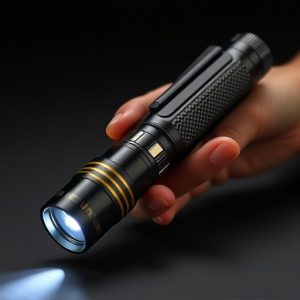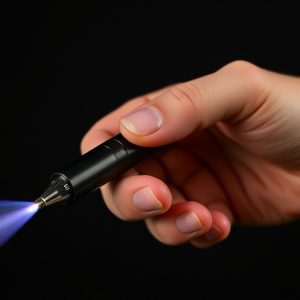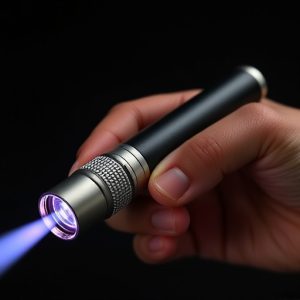Taser vs Stun Gun: Key Differences & Power Sources Explained
Pen stun guns, compact and powerful non-lethal self-defense devices, offer individuals discreet prot…….
Pen stun guns, compact and powerful non-lethal self-defense devices, offer individuals discreet protection through adjustable voltage probes that disrupt nerve signals. Smaller than Tasers, they have shorter ranges but are easily concealed and accessible for close-range de-escalation. While Tasers have longer battery life, pen stun guns require frequent battery replacement. Both tools disable targets temporarily, with pen stun guns popular for personal use and Tasers primarily employed by law enforcement in public safety situations. Legal regulations vary, highlighting the need to understand local laws before purchasing or using either device.
“Uncover the distinct worlds of Tasers and Stun Guns, two non-lethal force tools with unique capabilities. This comprehensive guide navigates the intricate differences between these devices, from their design and functionality to power sources and legal considerations. Understanding the intricacies of each empowers users when choosing between a Taser’s electric pulse or a stun gun’s electrical discharge for self-defense. Explore these options further, especially considering the convenience of a compact pen stun gun.”
- Understanding Tasers: Design and Functionality
- Stun Guns: A Comprehensive Overview
- Key Differences Between Tasers and Stun Guns
- Power Sources and Battery Life Comparison
- Applications and Legal Considerations
Understanding Tasers: Design and Functionality
Tasers, officially known as Electro-Muscular Disruption (EMD) devices, are non-lethal weapons designed to temporarily incapacitate a target through electrical impulse. Unlike traditional stun guns that use high voltage to disrupt nerve signals, tasers fire two small probes connected to wires, delivering an electric current between them. This unique design allows for precise control over the intensity of the shock, making tasers highly effective in de-escalating potentially dangerous situations.
The pen stun gun is a compact version of this technology, designed to fit comfortably in one’s hand or pocket. While smaller than standard tasers, they pack a significant punch, delivering powerful jolts capable of immobilizing an assailant. These devices are often favored by individuals seeking personal protection due to their ease of use and the element of surprise they provide.
Stun Guns: A Comprehensive Overview
Stun guns, often referred to as electroshock weapons or Tasers, are non-lethal self-defense devices designed to incapacitate a target by delivering an electric current through their body. These tools have gained popularity among individuals seeking personal protection, especially in high-risk professions and scenarios where the use of lethal force is not feasible or desirable. A pen stun gun is a compact version of this technology, offering users the convenience of a portable device that can be easily concealed and accessed when needed.
Stun guns operate by firing two small probes connected to wires, which make contact with the target’s skin. This allows for the transmission of a powerful electric current, causing muscle contractions and disorientation. The effects are temporary but can render an assailant immobile for several minutes, providing users with valuable time to escape or seek help. Modern stun guns, including pen stun guns, have evolved to include various features like adjustable voltage settings, different probe types, and even LED flashlights, making them versatile tools for personal safety in a wide range of situations.
Key Differences Between Tasers and Stun Guns
Tasers and stun guns are both non-lethal weapons designed to incapacitate individuals, but they operate on distinct principles. The primary difference lies in their method of delivering an electric shock. Tasers typically use two probes connected to thin wires that fire into the target, delivering a high-voltage, low-current electrical pulse. This disrupts muscle control, causing temporary paralysis. In contrast, stun guns emit a continuous electrical discharge over a longer period, using a higher current to override the body’s natural nervous system, also leading to temporary incapacitation.
Another key distinction is their range and power. Tasers generally have a shorter effective range, around 2-3 meters, while stun guns can deliver a shock from a distance of up to 10 meters or more with some models. Additionally, stun guns often produce a brighter flash and louder sound than tasers, making them more visible and audible, which can be an advantage in certain situations. Pen stun guns, compact and easily concealed, offer convenience but typically have shorter ranges and lower power output compared to their larger counterparts.
Power Sources and Battery Life Comparison
Taser and stun guns both rely on electrical energy to disrupt muscle control, but their power sources differ significantly. Tasers typically use a small, rechargeable battery that delivers high-voltage, low-current electric pulses through two probes connected to the device. This design allows for longer periods of active use between charges. In contrast, many pen stun guns utilize disposable batteries, which offer immediate power but require frequent replacement. While convenient for quick draws, this can result in shorter overall usage before needing a new battery. Battery life is a key consideration; tasers often come with indicators to monitor charge levels, while pen stun guns may require users to constantly check their remaining power.
When comparing battery life directly, tasers generally have an edge. With proper care and charging, a taser’s battery can last for hundreds of discharges, making it a reliable choice for prolonged use. Pen stun guns, on the other hand, often have shorter battery lifespans, typically lasting around 1-2 years depending on usage frequency. This means users must be prepared to carry extra batteries or switch them out regularly to avoid being caught off guard in situations where quick and continuous deployment is crucial, such as in self-defense scenarios involving aggressive assailants.
Applications and Legal Considerations
In terms of applications, both Tasers and stun guns serve as non-lethal weapons designed to temporarily incapacitate a target through electrical pulses. However, they differ significantly in their usage and legal considerations. A pen stun gun, for instance, is often smaller and more discreet, making it a popular choice for personal protection against potential attackers. Its application is typically close-range, used to shock and disrupt an assailant’s motor functions.
On the other hand, Tasers are generally considered law enforcement tools, employed during situations that pose a threat to public safety or when conventional control methods fail. They emit a pair of probes connected to electrical cables, delivering a powerful jolt from a distance. Legal considerations for stun guns and Tasers vary by jurisdiction, with some areas allowing their possession only by licensed individuals while others have more relaxed regulations. This difference underscores the need for users to thoroughly understand local laws before considering the purchase or use of either device.
In the pursuit of personal safety, understanding the nuances between a taser and a stun gun is essential. This article has provided an in-depth exploration of these two non-lethal weapons, highlighting their design, functionality, power sources, and legal applications. Tasers, with their unique electrical pulse technology, offer a powerful and effective means of immobilization, while pen stun guns provide a more compact and discreet option for personal defense. When considering self-defense tools, it’s crucial to weigh the differences in battery life, range, and the specific circumstances where each is most applicable. By arming ourselves with knowledge about these devices, we can make informed decisions to ensure our safety and security.


